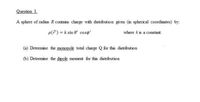Question

Transcribed Image Text:Question 1.
A sphere of radius R contains charge with distribution given (in spherical coordinates) by:
p(F') = k sin e' cosp'
where k is a constat.
(a) Determine the monopole total charge Q for this distribution
(b) Determine the dipole moment for this distribution
Expert Solution
This question has been solved!
Explore an expertly crafted, step-by-step solution for a thorough understanding of key concepts.
Step by stepSolved in 4 steps with 4 images

Knowledge Booster
Similar questions
- There are 3 thin conductive infinitly thin spherical shells with a charge on each shell of +2Q. The innermost shell has a radius of R. Another of the shells has a radius of 2R. The outermost shell has a radius of 3R. Draw a graph of E vs R. Make sure to show the values of E(3R), E(2R), and E(R). Note: (put R on the x axis)arrow_forwardA total amount of positive charge Q is spread onto a thin non-conducting circular annulus of inner radius a and outer radius b. The charge is distributed in a way so that the charge density per unit area is given by ? =??3, where r is the distance from the center of the annulus to any point on it and k is a constant.(a) Find an expression for the total charge Q on the annulus. (b) Find an expression for the potential V at the center of the annulus in term of Q, a and barrow_forwardTwo spherical, hollow conductors are concentrically nested as shown in the cross-sectional diagram below and electrically isolated from each other. A net charge of -3 nC is divided between the conductors, with a total of -12 nC on the inner conductor and +9 nC on the outer one. The charges are, of course, free to move between the surfaces within each shell but cannot move from one shell to the other. The inner conductor has an inner radius of a=2 cm, outer radius of b=3 cm. The outer conductor has an inner radius of c=6 cm, an outer radius of d=8 cm. a (a) In equilibrium, all of the excess charge is found on the surfaces. Why is there no charge between a and b, nor between c and d? (b) Determine the net charge on each surface (ie how much charge is there at r = a, at r = b, at r = c and at r= = d). (c) Is the charge on the outer surface equal to the net charge on the outer container, the net charge of the system, or some other amount? Explain briefly. (d) Find the surface charge…arrow_forward
- There are two uncharged concentric conducting spherical shells and a separate point charge. The smaller shell has an inner radius of 0.100m and an outer radius of 0.200m. The larger shell has an inner radius of 0.300m and and outer radius of 0.400m. A point charge of +10.0μC is placed between the two shells at a radius of 0.250m from the origin. Determine the net charge on each of the four surfaces (r = 0.1,0.2, 0.3, 0.4) and make a sketch that indicates BOTH the electric field lines and the surface charge densities. (this sketch does not have to be exactly mathematically correct, but use intuition)arrow_forwardA(n) 5.60-g sphere with net charge q is suspended directly above a fixed 7.80 C point charge at 2.35 cm of distance. How many excess electrons does the sphere of charge q have?arrow_forward
arrow_back_ios
arrow_forward_ios